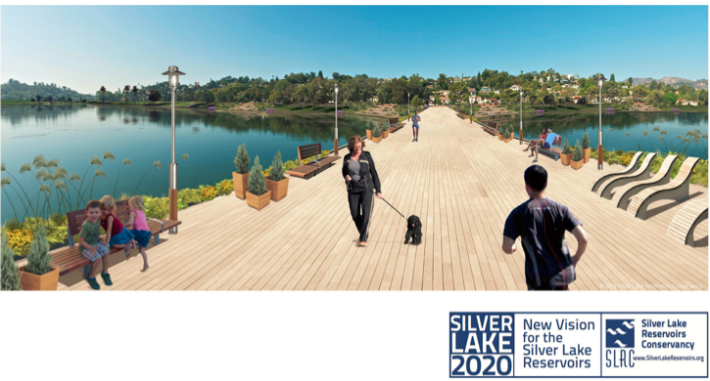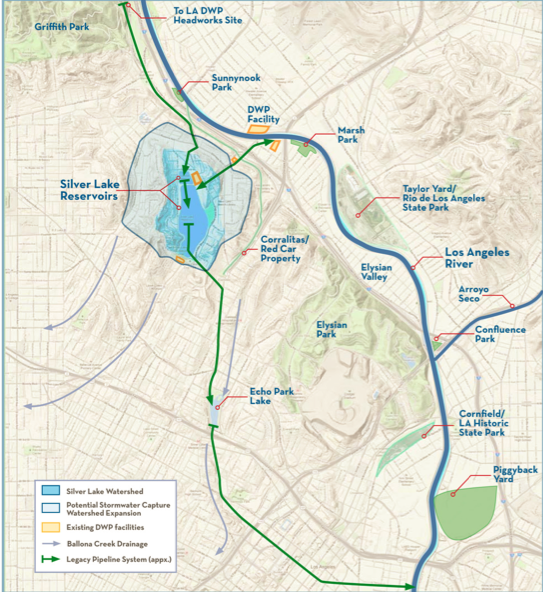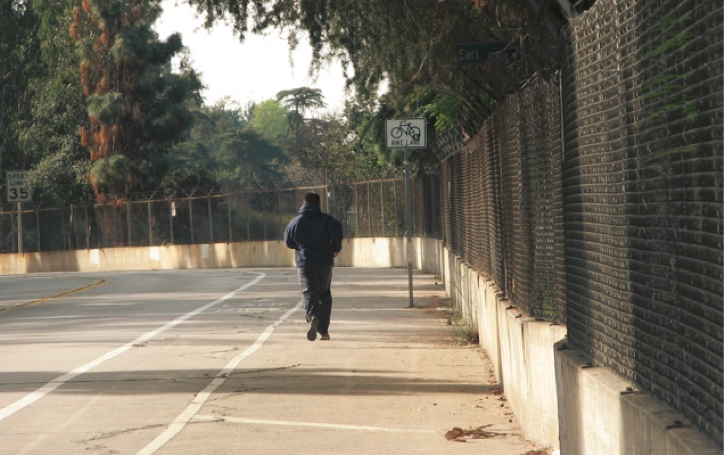A Vision for the Silver Lake Reservoirs: Opportunity for a More Livable City and Healthier River
10:33 AM PST on February 14, 2014

(Bruce Chan is an urban planner and designer in Los Angeles. He advocates for a more livable and sustainable city, and is on the Board of the Silver Lake Reservoirs Conservancy. His love for Los Angeles can be found at jiachi.tumblr.com.)
If the story of Los Angeles is the story of water, then the dramatic climax of that story might be fast approaching. The Silver Lake Reservoirs, due to recent Federal water quality regulations by the EPA, are being decommissioned. As part of that effort, the Los Angeles Department of Water and Power (DWP) will be temporarily draining the larger Silver Lake Reservoir to install a bypass pipe scheduled for the end of 2014.
The scheduled draining of the reservoir has raised new questions from the community. Will the reservoir be refilled? Will developers move in with housing projects? How much will this cost ratepayers? What about Ivanhoe Reservoir, and the black balls that cover it? Once the reservoirs are decommissioned, what is to become of them?
And there have been no shortage of creative ideas from the local design community, bringing these issues to the front pages of blogs and publications, ideas such as an esplanade, wetlands, a beach, and a surfing destination.
While the community is still weighing the pros and cons of the upcoming bypass pipe plan, the Silver Lake Reservoirs Conservancy (SLRC) is exploring long-term and regional opportunities that a large body of water can serve in L.A.’s urban core. The SLRC is proposing that the preservation of the open reservoirs can serve two transformative benefits to L.A.: the creation of public space in our park-poor city and the revitalized health of the Los Angeles River.
Public Space:
In LA’s ever increasing built-out urban core, the availability for natural public space is becoming harder and harder to come by. Many of our newest - and most dynamic - parks were existing public spaces that have been simply renovated or given a face-lift. Take the newly redesigned Grand Park in Downtown L.A. or the Echo Park Lake.
Both locally and across the country, cities are creatively turning to abandoned infrastructure as potential repurposed public space. The decline in rail usage has spurred now iconic public parks, such as the Los Angeles State Historic Park and the Highline in New York City, both previous sites for their city’s historically extensive rail infrastructure. Currently, Metro is studying repurposing the Harbor Subdivision Transit Corridor in South LA.
So is it out of the realm of possibility to envision the decommissioned Silver Lake Reservoirs as a truly accessible, fenceless, and ecologically rich public amenity?
The walking path around the reservoirs wasn’t always there. Local groups’ efforts, like the walking path and meadow, to ingrain the reservoirs complex as a public amenity help to ensure that the soon-to-be decommissioned bodies of water remain in the public trust. Photo by Leslie Edmonds, February 2006.
The Silver Lake Reservoirs already have many of the right elements to be a gem in LA’s repertoire of public spaces. The reservoirs boast a bustling 2.2-mile walking path, a popular dog park, sports facilities such as basketball courts, and the idyllic Meadow.
And yet, the natural backdrop for these amenities that draws people to this quiet neighborhood remains out of reach behind a fence: the water.
Envisioning the reservoirs more than just mere storage facilities, Mulholland himself recognized the magnetic attraction of water, stocking the Silver Lake Reservoir with fish and planting trees around its perimeter. It’s clear that the only way to preserve the soon-to-be decommissioned reservoirs as open bodies of water is to return them to the public trust as public space.
But how are we to sustainably keep the reservoirs filled, without the availability of pricey drinking water? That’s where the L.A. River comes in.
L.A. River:
Two recent announcements have immense implications for the future of the L.A. River. First, the Army Corp of Engineers released the long awaited ARBOR study, culminating with Mayor Garcetti lobbying the feds for Alternative 20. Then, on January 17th, Governor Brown declared a state of emergency for the state’s prolonged drought.
How is the city to proceed with these seemingly conflicted goals? The L.A. River that most of us know (the lush Glendale Narrows) is fed primarily with treated water coming from the Tillman Water Reclamation Plant and the Glendale Water Reclamation Plant. Without that additional discharge, the L.A. River would run dry most of the year, as it historically has. The growing popularity of the riparian wetlands, kayak excursions, and extensive bike path would be non-existent without the Tillman & Glendale plants.
So why not look for other reliable and sustainable sources of water for the river? That’s where the Silver Lake Reservoirs can step in.

Regional water management and public facilities for the Silver Lake Reservoirs; Courtesy of the SLRC
Excess recycled water, which currently is flushed down the L.A. river to the ocean, can be better regulated and stored in decommissioned reservoirs. During dry seasons when the plant releases less water, the reservoirs can help to maintain the river wetlands.
And we potentially wouldn’t have to build any new infrastructure to support it. Based on SLRC’s
initial research and publicly available reports, there are legacy infrastructure and existing pipelines which connect the reservoirs to the L.A. River via Fletcher Drive.
Los Angeles is also currently extensively developing its “Purple Pipe”, recycled water system. Treated water is being piped from the Glendale plant to city facilities such as the Griffith Park golf courses and Elysian Park. The proposed Taylor Yard Pedestrian Bridge even accommodates a recycled water line across the river.
Couldn’t these “Purple Pipes”, along with the L.A. River, also help to keep the reservoirs sustainably filled?
The bare bones are already there, but need a formal study which cannot be done without the help of LADWP , the current custodians of the reservoirs. That is why SLRC is calling for a feasibility study to be conducted focused on the existing pipes, linkages, and future of the Silver Lake Reservoirs.
In this sense, the discourse about the Silver Lake Reservoirs is not just about creating a singular pretty public park. It’s also about the whole Los Angeles River Revitalization and our city’s evolving relationship with water.
Get involved with the future of the reservoirs at www.silverlakereservoirs.org.
Stay in touch
Sign up for our free newsletter
More from Streetsblog Los Angeles
Metro Board Funds Free Student Transit Pass Program through July 2025
Metro student free passes funded another year - plus other updates from today's Metro board meeting
Eyes on the Street: New Lincoln Park Avenue Bike Lanes
The recently installed 1.25-mile long bikeway spans Lincoln Park Avenue, Flora Avenue, and Sierra Street - it's arguably the first new bike facility of the Measure HLA era
Brightline West Breaks Ground on Vegas to SoCal High-Speed Rail
Brightline West will be a 218-mile 186-mile-per-hour rail line from Vegas to Rancho Cucamonga - about 40 miles east of downtown L.A. - expected to open in 2028





